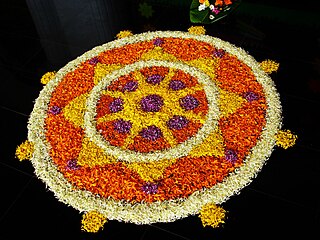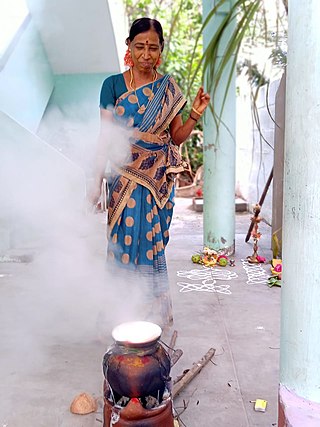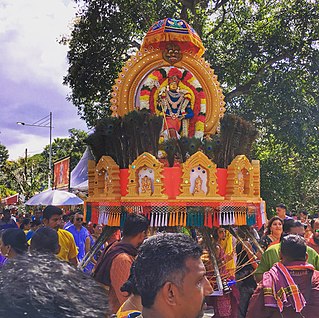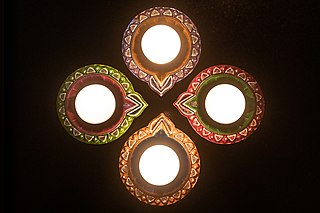Related Research Articles

The New Year is the time or day at which a new calendar year begins and the calendar's year count increments by one. Many cultures celebrate the event in some manner. In the Gregorian calendar, the most widely used calendar system today, New Year occurs on January 1. This was also the first day of the year in the original Julian calendar and the Roman calendar.

In the Gregorian calendar, New Year's Day is the first day of the calendar year, 1 January. Most solar calendars, such as the Gregorian and Julian calendars, begin the year regularly at or near the northern winter solstice. In contrast, cultures and religions that observe a lunisolar or lunar calendar celebrate their Lunar New Year at varying points relative to the solar year.

Onam is an annual harvest and Hindu cultural festival celebrated mostly by the people of Kerala. A major annual event for Keralites, it is the official festival of the state and includes a spectrum of cultural events.

Pongal is a multi-day Hindu harvest festival celebrated by Tamils. The festival is celebrated over three or four days with Bhogi, Thai Pongal, Mattu Pongal and Kanum Pongal, beginning on the last day of the Tamil calendar month of Margazhi, and observed on consecutive days. Thai Pongal is observed on the first day of the Tamil calendar month of Thai and usually falls on 14 or 15 January in the Gregorian calendar. It is dedicated to the solar deity Surya and corresponds to Makar Sankranti, the Hindu observance celebrated under various regional names across the Indian subcontinent.

Thaipusam or Thaipoosam is a Tamil Hindu festival celebrated on the first full moon day of the Tamil month of Thai coinciding with Pusam star. The festival is celebrated to commemorate the victory of Hindu god Murugan over the demon Surapadman. During the battle, Murugan is believed to have wielded a vel, a divine spear granted by his mother, Parvati.

Makar(a) Sankrānti, also referred to as Uttarāyana, Makara, or simply Sankrānti, is a Hindu observance and a mid-winter harvest festival in India and Nepal. It is typically celebrated on 14 January annually, this occasion marks the transition of the sun from the zodiac of Sagittarius (dhanu) to Capricorn (makara). As this transition coincides with the sun's movement from south to north, the festival is dedicated to the solar deity, Surya, and is observed to mark a new beginning. Across India, the occasion is celebrated with numerous multi-day festivals.

The Parthasarathy Temple is a 6th-century Hindu Vaishnavite temple dedicated to Vishnu in Chennai, India. Located in the neighbourhood of Thiruvallikeni, the temple is glorified in the Naalayira Divya Prabandham, the early medieval Tamil literature canon of the Alvar saints from the 6th to 9th centuries CE and is classified as among the 108 Divya Desams dedicated to Vishnu. The name 'Parthasarathy' means the 'charioteer of Arjuna', referring to Krishna's role as a charioteer to Arjuna in the epic Mahabharata.

Vaisakha is a month of the Hindu calendar that corresponds to April/May in the Gregorian Calendar. In the Indian national calendar, Vaisakha is the second month of the year. It is the first month of the Vikram Samvat calendar, Odia calendar, Maithili Calendar, Punjabi calendar, Assamese calendar and the Bengali calendar. This month lies between the second half of April and the first half of May.

Vaisakhi, also known as Baisakhi, marks the first day of the month of Vaisakh and is traditionally celebrated annually on 13 April and sometimes 14 April. It is seen as a spring harvest celebration primarily in Punjab and Northern India. Whilst it is culturally significant as a festival of harvest, in many parts of India, Vaisakhi is also the date for the Indian Solar New Year.

Ganesh Chaturthi, also known as Vinayaka Chaturthi or Vinayaka Chavithi or Vinayagar Chaturthi, is a Hindu festival celebrating the birthday of Hindu deity Ganesh. The festival is marked with the installation of Ganesha's murtis privately in homes and publicly on elaborate pandals. Observances include chanting of Vedic hymns and Hindu texts, such as prayers and vrata (fasting). Offerings and prasada from the daily prayers, that are distributed from the pandal to the community, include sweets such as modak as it is believed to be a favourite of Ganesha. The festival ends on the tenth day after start, when the murti is carried in a public procession with music and group chanting, then immersed in a nearby body of water such as a river or sea, called visarjana on the day of Ananta Chaturdashi. In Mumbai alone, around 150,000 murtis are immersed annually.

Gudi Padwa is a spring festival marking the start of the lunisolar new year for Marathi and Konkani Hindus. It is celebrated in and around Maharashtra, Goa & Damaon at the start of Chaitra, the first month of the lunisolar Hindu calendar. The festival is characterised by colourful floor decorations called rangoli, a special gudi dvaja; which is a saari or dhoti or other piece of cloth garlanded with flowers, mango & neem leaves; a sugar crystal garland called gathi, topped with upturned silver or copper vessels. Celebration also includes street gathering, dancing & festive foods.

Puthandu, also known as Tamil New Year, is the first day of year on the Tamil calendar that is traditionally celebrated as a festival by Tamils. The festival date is set with the solar cycle of the solar Hindu calendar, as the first day of the month of Chittirai. It falls on or about 14 April every year on the Gregorian calendar. The same day is observed elsewhere in South and South East Asia as the traditional new year, but it is known by other names such as Vishu in Kerala, and Vaisakhi or Baisakhi in central and northern India.

The culture of Chennai, popularly called the "Gateway to the South India", is distinct from that of any other Indian city. Chennai continues to be traditional and conventional in certain ways. Traditional music, dance and all other art forms of Tamil Nadu are very popular in the city. One can find a peculiar cultural blend in city, from traditional foods to fast foods, from ancient temple architecture to modern high-rises, and from classical music and dance to the growing nightlife.

A diya, diyo, deya, deeya, dia, divaa, deepa, deepam, deep, deepak or saaki is an oil lamp made from clay or mud with a cotton wick dipped in oil or ghee. These lamps are commonly used in the Indian subcontinent and they hold sacred prominence in Hindu, Sikh, Buddhist, and Jain prayers as well as religious rituals, ceremonies and festivals including Diwali.

The Thimithi or firewalking ceremony is a Hindu festival originating in Tamil Nadu, South India that is celebrated a week before Deepavali, during the month of Aipasi of the Tamil calendar. The fire-walking ceremony is in honour of the goddess Draupati Amman, who is considered the incarnation of goddess Mariamman, and is practiced not only in India, but also in countries with large Tamil populations like Sri Lanka, Fiji, Singapore, Malaysia, Mauritius, Réunion, South Africa and others.

Nachiyar Kovil or Thirunarayur Nambi Temple is a Hindu temple in Thirunarayur, a village in the outskirts of Kumbakonam in the southern Indian state of Tamil Nadu, is dedicated to the Hindu god Vishnu and her consort lakshmi. Nachiyar koil is one of 2 divyadesams were Lakshmi is pradaana over Vishnu. Thirunaraiyur is the sub urban region of business city of Kumbakonam.

Navaratri is an annual Hindu festival observed in honor of the goddess Durga, an aspect of Adi Parashakti, the supreme goddess. It spans over nine nights, first in the month of Chaitra, and again in the month of Ashvin (September–October). It is observed for different reasons and celebrated differently in various parts of the Hindu Indian cultural sphere. Theoretically, there are four seasonal Navaratris. However, in practice, it is the post-monsoon autumn festival called Sharada Navaratri. There are 2 Gupta Navaratris or "Secret Navaratris" as well, one starting on the Shukla Paksha Pratipada of the Magha Month and another starting in the Shukla Paksha Pratipada of Ashadha Month.

Rama Navami is a Hindu festival that celebrates the birth of Rama, one of the most popularly revered deities in Hinduism, also known as the seventh avatar of Vishnu. He is often held as an emblem within Hinduism for being an ideal king and human through his righteousness, good conduct and virtue. The festival falls on the ninth day of the bright half of the lunar cycle of Chaitra (March–April), the first month in the Hindu calendar. It is also part of the Chaitra Navaratri festival in spring. Rama Navami is a holiday for government employees in India.

Utsava, also referred to as Utsavam, generally means a festival or celebration or any joyous occasion, mostly associated with Hinduism. It also carries the meaning of delight, merriment and pleasure. The Sanskrit word utsava comes from the word "ut" meaning "removal" and "sava" which means "worldly sorrows" or "grief". According to Hindu tradition, utsava are specific to festivals associated with temples.
Culture of Coimbatore is based on the culture of the Kongu Nadu region and is distinctly unique. Being a cosmopolitan city, the culture of the city reflects its diverse population which has resulted in a unique blend. Though it is generally considered a traditional city, Coimbatore is more diverse and cosmopolitan than other cities in Tamil Nadu. Traditional music, dance and all other art forms of Tamil Nadu are very popular in the city. One can find a unique blend of culture from traditional foods to fast foods, from ancient temple architecture to modern high-rises and from classical music and dance to the growing nightlife in the city. Popularly called as the Manchester of South India, the city is known for its industries and has developed a reputation for entrepreneurship.
References
- 1 2 ""Hindus end atonement festival of Kavady"". SABC News . 24 April 2005. Archived from the original on 24 April 2005.
- 1 2 "Devotees celebrate Kavady festival in Lenasia". SABC News. 26 January 2005. Archived from the original on 25 April 2005.
- ↑ "Indian community celebrates Kavady festival". SABC. 9 May 2004. Archived from the original on 25 April 2005.